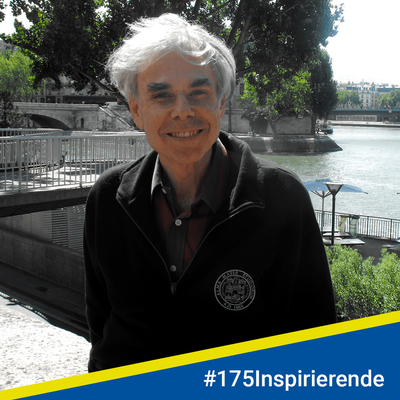Douglas R. Hofstadter
"I am fascinated by the pervasive role of analogy-making in discovery in physics, and as a cognitive scientist, I have on occasion given lectures on the ubiquity of analogies in the historical development of physics."
Douglas Hofstadter (Distinguished Professor for cognitive science and comparative literature at Indiana University, Bloomington, USA) discovered as a graduate student in physics in the 1970s the so-called “Hofstadter butterfly” — a graph of the energy levels of crystal electrons in a magnetic field — which was the first fractal ever found in physics. He is best known for his books on minds, thinking, consciousness, and the nature of the self, or the “I” including Gödel, Escher, Bach (Pulitzer Prize for General Nonfiction 1980), The Mind’s I,and I Am a Strange Loop.

If I hadn't become a physicist…
Actually, I didn’t become a physicist, because, during my eight-year stint as a physics graduate student (part of which was spent in Regensburg), I discovered, to my shock and chagrin, that my mind just didn’t work like a physicist’s mind. Luckily, however, while in graduate school, I discovered a different intellectual direction that I could follow, which was that of thinking about how the mind works (especially trying to devise computer models of mental processes). And that’s what I wound up doing for the next few decades.
What else moves you besides physics and work?
These days I am a writer more than anything else. For about a year now, I’ve been working very hard on a book called “My Wild Grace Chase”, which is an autobiographical memoir all about my intense lifelong quest after beauty in many guises and many arenas of life — music, art, mathematics, physics, nature, languages, literature, letterforms, poems, photography, dance, films, friendship… It will be a behemoth of a book, making “War and Peace” look puny by comparison, alas. But I just have to write it, and then, when it’s done, I’ll have to figure out what can be done with it. We shall see…
For me, music is the greatest art, and I occasionally play piano and occasionally write small pieces for piano, influenced primarily by such composers as Bach, Chopin, Rachmaninoff, Scriabin, Ravel, Poulenc, and Prokofiev (and many others, but that’s just a sample).
Over the decades I have also done a lot of art that involves intricate lines twisting and tangling with each other, in a kind of polyphonic manner. Much of my art was influenced by fanciful playing-around with the letterforms of our own alphabet, but even more by borrowing shapes from the alphabets of the Indian subcontinent, such as Sinhalese, Tamil, Malayalam, Bengali, Devanagari (the writing system of Hindi), and so forth.
I have also done thousands of ambigrams (pieces of calligraphy that have two different readings, depending on how you look at them).
Should physicists become more involved in political discourse or everyday life?
Every thinking person should become involved in political and social issues, because unfortunately, and for many reasons, humanity is in serious danger today (climate change, populism, nationalism, pandemics, the arms race, the loss of respect for truth, the loss of respect for expertise, the pervasiveness of social media, the domination of society by advertising…).
What topic(s) did your thesis deal with?
In doing my Ph.D. research, in the years 1974–75, I discovered that the energy levels of crystal electrons in a magnetic field, when plotted against magnetic-field strength, yielded a graph that consisted of infinitely many smaller (and distorted) copies of itself, and those smaller copies consisted, in turn, of infinitely many smaller (and distorted) copies of themselves. This kind of structure (later termed a “fractal”) was unprecedented in physics, and it revealed, among other things, that number theory plays a significant role in certain areas of physics.
Which questions in physics inspire you most today?
I am fascinated by the pervasive role of analogy-making in discovery in physics, and as a cognitive scientist, I have on occasion given lectures on the ubiquity of analogies in the historical development of physics.
I would like to say one more thing
Sadly enough, I find contemporary physics too difficult and too strange to understand it (let alone to practice it myself). In fact, some of today’s physics strikes me as being totally ungrounded in reality (for example, supersymmetry, some of cosmology [especially going back to the first 10^-35 second], string theory, multiverses, and on and on). I see these areas of contemporary physics as akin to pseudoscience, or even to fairy tales.
I have, in short, a love–hate affair with physics. I love much of physics, but I hate much of it with equal passion. It would have been a stormy marriage, to say the least, had I stayed in it. So physics and I got divorced in 1976 or so, but luckily, we have what you might call an “amicable divorce”.
Photo credit : Alexandra Vorobyova